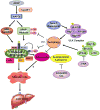Role and mechanisms of autophagy in acetaminophen-induced liver injury
- PMID: 29682868
- PMCID: PMC6105454
- DOI: 10.1111/liv.13866
Role and mechanisms of autophagy in acetaminophen-induced liver injury
Abstract
Acetaminophen (APAP) overdose is the most frequent cause of acute liver failure in the USA and many other countries. Although the metabolism and pathogenesis of APAP has been extensively investigated for decades, the mechanisms by which APAP induces liver injury are incompletely known, which hampers the development of effective therapeutic approaches to tackle this important clinical problem. Autophagy is a highly conserved intracellular degradation pathway, which aims at recycling cellular components and damaged organelles in response to adverse environmental conditions and stresses as a survival mechanism. There is accumulating evidence indicating that autophagy is activated in response to APAP overdose in specific liver zone areas, and pharmacological activation of autophagy protects against APAP-induced liver injury. Increasing evidence also suggests that hepatic autophagy is impaired in nonalcoholic fatty livers (NAFLD), and NAFLD patients are more susceptible to APAP-induced liver injury. Here, we summarized the current progress on the role and mechanisms of autophagy in protecting against APAP-induced liver injury.
Keywords: acetaminophen; acetaminophen protein adducts; autophagy; liver injury; mitophagy.
© 2018 John Wiley & Sons A/S. Published by John Wiley & Sons Ltd.
Conflict of interest statement
Figures


Similar articles
-
Removal of acetaminophen protein adducts by autophagy protects against acetaminophen-induced liver injury in mice.J Hepatol. 2016 Aug;65(2):354-62. doi: 10.1016/j.jhep.2016.04.025. Epub 2016 May 2. J Hepatol. 2016. PMID: 27151180 Free PMC article.
-
Autophagy and acetaminophen-induced hepatotoxicity.Arch Toxicol. 2018 Jul;92(7):2153-2161. doi: 10.1007/s00204-018-2237-5. Epub 2018 Jun 6. Arch Toxicol. 2018. PMID: 29876591 Review.
-
Adiponectin protects against acetaminophen-induced mitochondrial dysfunction and acute liver injury by promoting autophagy in mice.J Hepatol. 2014 Oct;61(4):825-31. doi: 10.1016/j.jhep.2014.05.033. Epub 2014 Jun 2. J Hepatol. 2014. PMID: 24882054
-
Enhanced autophagy contributes to protective effects of IL-22 against acetaminophen-induced liver injury.Theranostics. 2018 Jul 30;8(15):4170-4180. doi: 10.7150/thno.25798. eCollection 2018. Theranostics. 2018. PMID: 30128045 Free PMC article.
-
Acetaminophen-induced liver injury in obesity and nonalcoholic fatty liver disease.Liver Int. 2014 Aug;34(7):e171-9. doi: 10.1111/liv.12514. Epub 2014 Mar 21. Liver Int. 2014. PMID: 24575957 Review.
Cited by
-
Goji Ferment Ameliorated Acetaminophen-Induced Liver Injury in vitro and in vivo.Probiotics Antimicrob Proteins. 2023 Oct;15(5):1102-1112. doi: 10.1007/s12602-022-09956-y. Epub 2022 Jul 7. Probiotics Antimicrob Proteins. 2023. PMID: 35796949
-
Dysfunction of autophagy in high-fat diet-induced non-alcoholic fatty liver disease.Autophagy. 2024 Feb;20(2):221-241. doi: 10.1080/15548627.2023.2254191. Epub 2023 Sep 12. Autophagy. 2024. PMID: 37700498 Free PMC article. Review.
-
Dendrobium nobile Lindl. alkaloids protect CCl4-induced acute liver injury via upregulating LAMP1 expression and activating autophagy flux.J Nat Med. 2025 Jan;79(1):180-195. doi: 10.1007/s11418-024-01852-9. Epub 2024 Nov 15. J Nat Med. 2025. PMID: 39546174
-
Hepatocyte-Specific Deficiency of DAX-1 Protects Mice from Acetaminophen-Induced Hepatotoxicity by Activating NRF2 Signaling.Int J Mol Sci. 2022 Oct 4;23(19):11786. doi: 10.3390/ijms231911786. Int J Mol Sci. 2022. PMID: 36233086 Free PMC article.
-
Long-Term Consumption of Food-Derived Chlorogenic Acid Protects Mice against Acetaminophen-Induced Hepatotoxicity via Promoting PINK1-Dependent Mitophagy and Inhibiting Apoptosis.Toxics. 2022 Nov 5;10(11):665. doi: 10.3390/toxics10110665. Toxics. 2022. PMID: 36355956 Free PMC article.
References
-
- HERNDON CM, DANKENBRING DM. Patient perception and knowledge of acetaminophen in a large family medicine service. J Pain Palliat Care Pharmacother. 2014;28(2):109–16. - PubMed
-
- NOURJAH P, AHMAD SR, KARWOSKI C, WILLY M. Estimates of acetaminophen (Paracetomal)-associated overdoses in the United States. Pharmacoepidemiol Drug Saf. 2006;15(6):398–405. - PubMed
-
- MANTHRIPRAGADA AD, ZHOU EH, BUDNITZ DS, LOVEGROVE MC, WILLY ME. Characterization of acetaminophen overdose-related emergency department visits and hospitalizations in the United States. Pharmacoepidemiol Drug Saf. 2011;20(8):819–26. - PubMed
Publication types
MeSH terms
Substances
Grants and funding
LinkOut - more resources
Full Text Sources
Other Literature Sources
Medical

